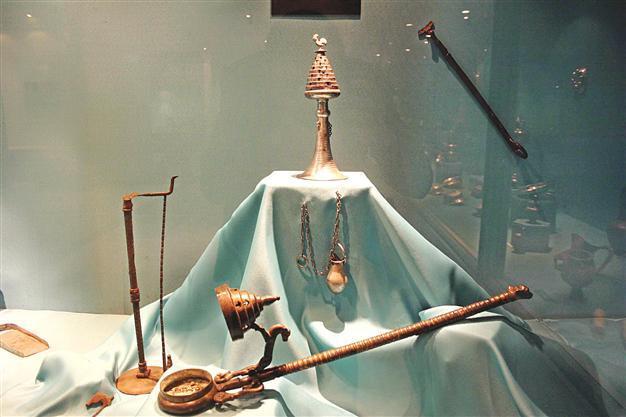New Uşak museum to house renowned Karun treasures
UŞAK - Doğan News Agency

The new museum complex will be established in the city’s historical train station on an area of 2,500 square-meter. DHA photo
Construction has begun on a modern museum that will house the famous Karun treasure, the symbol of the Aegean province of Uşak, as part of a new museum complex in the Historical Uşak Train Station.Talks on establishing an museum complex in the Historical Uşak Train Station lasted four years. The foundation of the Uşak Archaeology Museum will be laid by Culture and Tourism Minister Ertuğrul Günay, and the project will be finished by the end of 2013.
Provincial Culture and Tourism Director Şerif Arıtürk said the excavation work had been finished on an area of 2,500 square meters and the foundation of the museum would be laid. “Minister Günay will come to the city in the coming days and lay its foundation. New projects for the display rooms of the museum will be prepared by the technical staff of the ministry. When the museum is completely done, the artifacts will be moved there, and it will open in the beginning of 2014.”
Arıtürk said cities with museums had an identity. “Artifacts in museums reveal the history and social structure of cities. This is why Uşak needs to have a unique and special museum. The city has been home to various civilizations since 4000 B.C. Artwork from these civilizations will be displayed in this modern museum. We have received support from the Foundation for the Promotion and the Protection of the Environment and Cultural Heritage (ÇEKÜL) for the museum construction project. As a result, we will preserve original materials from the Uşak Train Station and establish a modern museum,” he said.
Another project
Arıtürk said Uşak was one a few Turkish cities where steam trains and their parts were stored. “Even film teams come to the city and shoot their films in the train station. When we open a transportation museum in the city, this region will become an attraction center. As part of the speed train project, which is planned for 2015, we will also open a transportation museum in the train station. When the museum complex is finished, Uşak will become a center where people spend their weekends.”
He said the allocation of the land of the Historical Uşak Train Station to the ministry for the establishment of the museum complex had taken a long time. “The land is owned by Turkish State Railways. The tender for the Uşak Archaeology Museum was made in July and the land was transferred to the construction company,” Arıtürk said.
The museum will cost 10 million Turkish Liras, according to Arıtürk. “With three floors and a ground floor, the museum will total 8,200 square meters on a 2,500-square-meter plot of land. The total size of the land is 84,000 square meters and three more museums will be constructed there in the next years.”
Dating back to Lydian king
The Karun Treasure, which dates back to the period of the Lydian King Croesus between 560 and 546 BC, was unearthed from the tumulus, or burial mounds, near the Güre district on the İzmir highway in 1960. It is also widely known as the Lydian Treasure.
The treasure, one of the most significant works in the Lydian period, was smuggled from Uşak within three years between 1965 and 1968. The first smuggling took place in Toptepe Tumulus in 1965. A group of five people dug a tunnel and reached the burial chamber. They sold the artifacts for 65,000 Turkish Liras.
Later, in 1966, the İkiztepe tumulus was looted by 11 people and 150 pieces in the burial chamber were sold for 150,000 liras. A third robbery took place in 1968 in the Aktepe tumulus. The paintings and other artifacts were sold for 40,000 liras.
The entire treasure was discovered in 1985 at the New York Metropolitan Museum by journalist Özgen Acar. The Culture Ministry filed a lawsuit in 1987 to get back the treasure, which was kept in the depot of the museum. As a result of the legal process, which cost $40 million, the treasure was returned to Turkey in 1993.
















